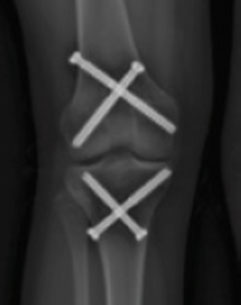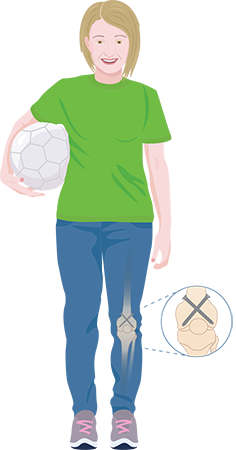
Screws and plates are placed into the bone at the top and bottom of the growth plate, which prevent it from growing.
Surgeons can also scoop out cartilage to permanently stop growth.
One method to correct a leg length discrepancy is to slow down the growth of the longer leg, providing the shorter leg an opportunity to catch up in growth to the longer leg.
When bones are still growing, correcting limb length discrepancy can be accomplished with surgery that slows down or stops the growth of the longer limb. For adults, this procedure is not an option.
Each of the long bones in your lower limb (femur, tibia, fibula) has a growth center at the top and bottom of the bone. Your surgeon can selectively slow the growth of a bone by targeting one or more of the growth centers in the bones of the longer leg.
Epiphysiodesis is a procedure that fuses the epiphyseal (growth) plate – either temporarily or permanently – to cause growth arrest in the good leg. This will not instantly fix the leg length discrepancy. Instead, the leg length discrepancy slowly lessens as the shorter limb catches up.
 There are several common methods of epiphysiodesis surgery. Surgeons can drill the growth center, place screws across the growth center, or tether each side of the growth center with a small plate to prevent the bone from growing. They can also remove the remaining cartilage to permanently stop growth.
There are several common methods of epiphysiodesis surgery. Surgeons can drill the growth center, place screws across the growth center, or tether each side of the growth center with a small plate to prevent the bone from growing. They can also remove the remaining cartilage to permanently stop growth.
Growth arrest may be used in conjunction with limb lengthening surgery for a large limb length discrepancy to avoid additional lengthening procedures. For example, if you have a 10 cm inequality and have already gained 7 cm by lengthening, growth arrest could result in limb length equality for the final 3 cm without additional surgery.
Timing is key for this procedure. A surgeon must accurately predict the full potential height and determine at what time in adolescence the procedure should be performed so that limbs are near-equal length by the end of skeletal growth.
Despite all of medicine’s technological advances, determining the exact time to perform an epiphysiodesis is still just an educated guess. The surgeon needs to evaluate the remaining growth potential and decide when it is the right time to stop growth to obtain the desired correction. The surgeon also needs to choose which growth center (or centers) need to stop to obtain the correction.
This evaluation process is still an inexact science. In most cases, your surgeon should be able to estimate the timing fairly accurately, but it is possible to under-correct or over-correct the leg lengths with epiphysiodesis.
Also, the idea of this surgery is to slow down the growth of the longer limb to let the shorter limb catch up in growth – which, in the case of a leg length discrepancy, would mean the patient will lose some height. The amount of height lost will be equal to the amount of the desired leg length discrepancy correction.
For example, if the patient has a 2 cm leg length discrepancy, the patient would potentially lose 2 cm of height to obtain equal leg lengths. If the difference is small, this may not be a concern to the patient. However, for patients that are not expected to be very tall at the end of growth, losing height may not be acceptable.
Note: If an epiphysiodesis was performed but there is still a leg length discrepancy at the end of growth, any of the other treatments for leg length discrepancy can still be used. For example, a shoe lift could be placed under the short leg if the leg length discrepancy is small. For larger remaining discrepancies, the shorter limb could be lengthened or the longer limb could have a segment of bone removed to shorten it.
